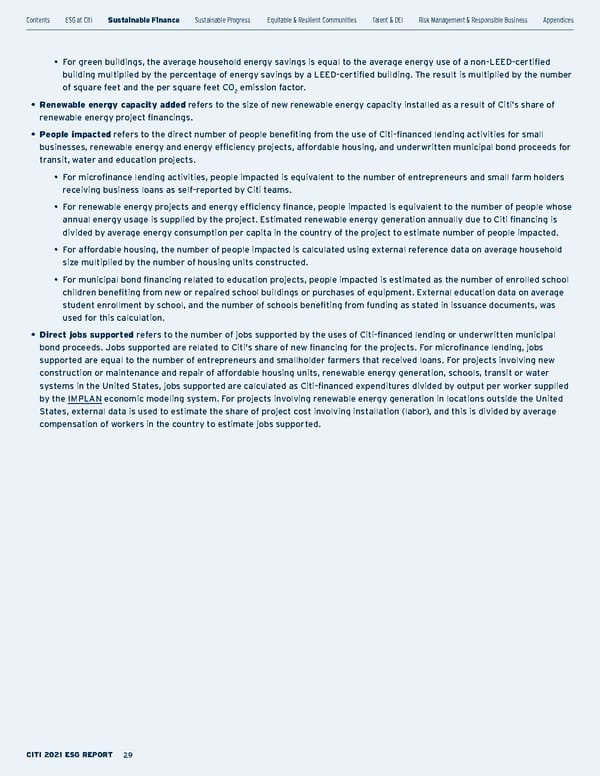• For green buildings, the average household energy savings is equal to the average energy use of a non-LEED-certified building multiplied by the percentage of energy savings by a LEED-certified building. The result is multiplied by the number of square feet and the per square feet CO 2 emission factor. • Renewable energy capacity added refers to the size of new renewable energy capacity installed as a result of Citi’s share of renewable energy project financings. • People impacted refers to the direct number of people benefiting from the use of Citi-financed lending activities for small businesses, renewable energy and energy efficiency projects, affordable housing, and underwritten municipal bond proceeds for transit, water and education projects. • For microfinance lending activities, people impacted is equivalent to the number of entrepreneurs and small farm holders receiving business loans as self-reported by Citi teams. • For renewable energy projects and energy efficiency finance, people impacted is equivalent to the number of people whose annual energy usage is supplied by the project. Estimated renewable energy generation annually due to Citi financing is divided by average energy consumption per capita in the country of the project to estimate number of people impacted. • For affordable housing, the number of people impacted is calculated using external reference data on average household size multiplied by the number of housing units constructed. • For municipal bond financing related to education projects, people impacted is estimated as the number of enrolled school children benefiting from new or repaired school buildings or purchases of equipment. External education data on average student enrollment by school, and the number of schools benefiting from funding as stated in issuance documents, was used for this calculation. • Direct jobs supported refers to the number of jobs supported by the uses of Citi-financed lending or underwritten municipal bond proceeds. Jobs supported are related to Citi’s share of new financing for the projects. For microfinance lending, jobs supported are equal to the number of entrepreneurs and smallholder farmers that received loans. For projects involving new construction or maintenance and repair of affordable housing units, renewable energy generation, schools, transit or water systems in the United States, jobs supported are calculated as Citi-financed expenditures divided by output per worker supplied by the IMPLAN economic modeling system. For projects involving renewable energy generation in locations outside the United States, external data is used to estimate the share of project cost involving installation (labor), and this is divided by average compensation of workers in the country to estimate jobs supported. Contents ESGatCiti SustainableFinance SustainableProgress Equitable&ResilientCommunities Talent&DEI RiskManagement&ResponsibleBusiness Appendices CITI 2021 ESG REPORT 29
 Citi ESG Report Page 28 Page 30
Citi ESG Report Page 28 Page 30